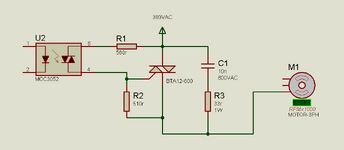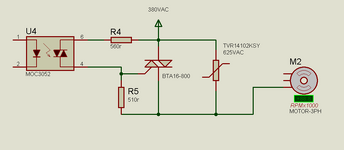tyilgin
Junior Member level 2
Hi;
I am working on a design for three phase motor control in the range of 0.75 .. 2KW
As you know, when the triacs are not conducting, a few mA leakage occurs to the output via the snubber capacitor.
I'm thinking of using varistor instead of RC snubber to get rid of this leak.
May I know your thoughts on this change please?
Note:
1- I have come across many articles recommending R2 against leakage of MOC3052. I would appreciate it if you could write your comments on this subject.
2- I think BTA12-600 is at the limit. Even though I am using it in the prototype for now, I know that I will have to replace it with BTA16-800 in the future.
I am working on a design for three phase motor control in the range of 0.75 .. 2KW
As you know, when the triacs are not conducting, a few mA leakage occurs to the output via the snubber capacitor.
I'm thinking of using varistor instead of RC snubber to get rid of this leak.
May I know your thoughts on this change please?
Note:
1- I have come across many articles recommending R2 against leakage of MOC3052. I would appreciate it if you could write your comments on this subject.
2- I think BTA12-600 is at the limit. Even though I am using it in the prototype for now, I know that I will have to replace it with BTA16-800 in the future.

